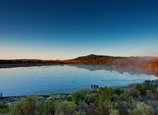
Onerous Task
The new tourist center may reduce human damage, but cannot halt the relentless course of erosion.
The Mogao Grottoes are located on a cliff on the east side of Mingsha Mountain, which extends for 1,700 meters. First built in AD 366, the grottoes were under construction for an entire millennium. They reached an immense scale in the 14th century. There are now 492 caves that house murals covering 45,000 square meters and 2,415 painted clay sculptures. Cave 17, discovered by the Taoist Wang in the early 20th century, is a repository for more than 50,000 ancient documents and artworks. The Mogao Grottoes comprise the world's largest extant shrine of Buddhist art. They have engendered a specific discipline – Dunhuangology – that entails research on the Mogao documents and grotto art. The grottoes were designated a UNESCO World Heritage Site in 1987.
Blights, however, like hollowing, peeling, flaking, discoloring and mildew, are apparent in more than half of the Mogao murals and painted sculptures.
The effects of natural erosion are plain to see from two photos Fan showed us. They are both of a mural on the north wall of Cave 285 taken within a 100-year period. The first, taken by French sinologist Paul Pelliot in 1908, is of a more or less complete mural with easily identifiable figures. The second, taken in 2002, shows how the central part is peeling and the figures are too faded to decipher.
Of the proposals Fan has raised, one is a complex project called "three lines of defense." It consists of cliff reinforcement, construction of a plank path and complex protection from sand storms. The National Development and Reform Commission approved the project in December 2007. All sub-projects, other than the tourism center, passed the acceptance inspection last January.
A native of humid Shanghai, Fan Jinshi found it difficult to adapt to Dunhuang's arid climate. "It's so dry here, with an annual rainfall of only 30 millimeters," she said. "I never imagined that the caves could suffer from water seepage." The cliffs of Mingsha Mountain are glutenite, which means that rain water penetrates minute cracks and gra-dually seeps behind the murals.
Water infiltration within the cliffs is the main culprit of the murals' maladies, according to Fan. As mud is their main substance, they swell under humidity and shrink after drying. This process causes flaws and blights. The cliff reinforcement project is expected to reduce the risk of both landslides and rainwater infiltration.
The Dunhuang Academy has worked with the Getty Research Institute and the Cold and Arid Regions Environmental and Engineering Research Institute, Chinese Academy of Sciences, on controlling sand storms. They have hit on a complex system comprising high nylon fences on the cliff and a psammophyte belt to repel sand. They have also established grids of cotton stalks and wheat straws to fix the sand, and constructed a drip irrigation system and water pipes. After 20 years sand storms in the Mogao Grottoes area decreased 75 percent, reducing erosion of the cliff, murals and painted sculptures.
The security and monitoring system, however, failed to meet today's demands. The new security project, initiated in July 2009, entails a more advanced technological security system. Covering all caves and their priceless artifacts, it pinpoints the specific location of alarms triggered by both images and sounds. It also includes micro-monitoring of temperature, humidity, carbon dioxide and the number of visitors in the caves. The system thus constitutes a scientific base for cave and tourist management.


















 Migrant children’s dream of stage
Migrant children’s dream of stage


![]()
